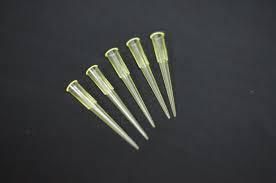Over the years, chemists, molecular biologists, and practitioners in the medical field have relied on various measuring items when handling fluids. These items come in multiple shapes and sizes; they range from measuring cylinders, conical flasks beakers, and pipettes. Several other items hand in hand with these items such as tongs to hold heated glass apparatus and yellow pipette tips.

One of the widely used measurement items in the laboratory is the pipette. This apparatus is often used in chemistry, medicine, and biology to transport small specific volumes fluid. Pipettes have various designs and accessories suited for multiple uses.
Designs and uses of pipettes
The evolution of pipettes and their accessories traces its roots to two main categories, which are.
- Measuring pipettes. They usually measure volumes between 0.1ml to 25ml. They come in long tubes that are clearly calibrated and with a tapering end. This gives these pipette the ability to hold two measurements of a fluid at a time. They are available in two subcategories, namely mohr and serological pipettes.
- Volumetric pipettes. These are used within the lab to transfer liquids of specific volumes, usually between 1ml to100ml. They assume the shape of a rolling pin with two thinner glass ends on either side and a bulb in the center.
Below are some of the designs and accessories that been inspired by the two main categories
Fixed volume pipettes
This design of pipettes is used to dispense fixed volumes of fluids, especially dense or liquids with high viscosity. Unlike other pipettes, the measurements or the capacity of the fluids they hold is fixed. They are suitable for dispensing the same quantity of liquids. Fixed volume pipettes are ideal for beginners.
Variable volume pipettes
Unlike the fixed volume pipette, the variable volume pipette allows the user to draw and dispense a desired measurement of fluids. This is possible as long as the pipette can draw and dispense that volume of liquid.
Bulb and squeeze top pipettes
These two types of pipettes use the same mechanism to operate. These apparatus contain two main parts an oval or round bulb made of rubber or plastic material. The second part consists of a transparent calibrated equipment. The bulb act as a vacuum, and upon squeezing and releasing it draws the intended fluids. Though they are inexpensive, they are not so accurate.
Motorized pipettes
These pipettes are easy to use. They have triggers that are touch sensitive and usually have LCD displays. They are battery operated with options of rechargeable or disposable batteries.
Pipette parts and accessories
The ever-evolving world of science and technology has not spared the industry to the introduction of a wide range of gadgets and accessories. These are designed to make work easier as well as to offer high accuracy levels. The accessories include;
- Pipette stands. These are available in either carousel or linear designs.
- Pipette jars which come in a variety of sizes.
- Pipette rinsers
- Pipette tray rack
- Pipette can racks
- Holder clamps
- Pipette support stands
- Rotary support stands
- Pipette and tip storage systems.
- Reagent reservoirs
- Support stands(wired)
- Weighted bases
- Wall mounted racks
- Stainless steel racks
The above are some of the widely used and readily available accessories to make your pipette use easier.
Pipette tips
These tips are handy if accurate readings and measurements are anything to go by. They are classified into three main categories sterile, non-sterile, and filtered.
Non-sterile tips
They are used in most laboratory procedures where sterilization is not much of an issue. Yellow pipette tips belong to this category.
Sterile tips
Sterile tips are certified tips that are free of human DNA and other possible contaminations; these are important in cases that a lot of accuracies are required. They are made of 100% polypropylene material.
Filtered tips
These pipette tips are designed to prevent aerosols from forming in the laboratory. Aerosols account for 65% of all lab infections. Procedures such as forensics and clinical diagnostics are considered very sensitive and prone to contamination, to avoid the possibility of this, the filtered tips are used.
The use of pipettes has evolved over the years with the industry shifting from the use of potentially dangerous methods such as sipping the fluids with the mouth. This posed great dangers such as the possibility of sipping in hazardous chemicals, spillage, and inhaling harmful fumes. All these products and accessories are designed to give the accuracy, best possible results and at the same time providing exceptional safety standards.
